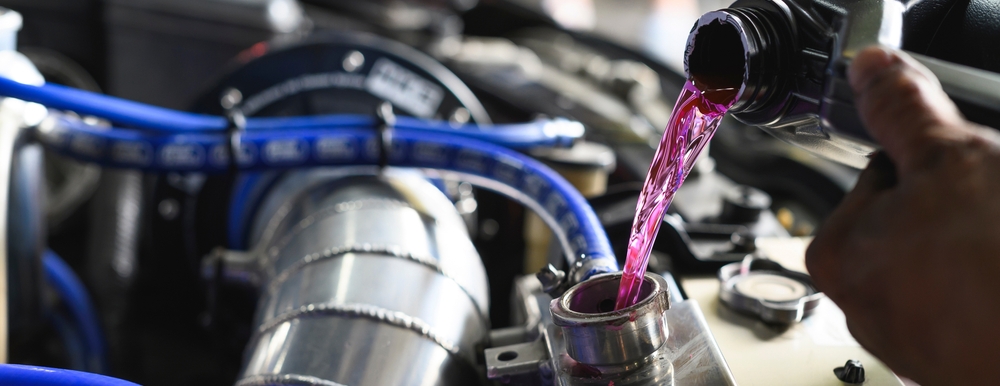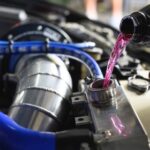
30 May Auto Fluids: A Complete Maintenance Checklist
 Auto fluids play a huge role in every mechanical system in your car. They also contribute to vehicle safety, fuel economy, and performance. Most of us are familiar with the top three auto fluids: engine oil, brake fluid, and coolant, but what about the others? Below is a brief breakdown of common auto fluids found in most conventional vehicles on the road today.
Auto fluids play a huge role in every mechanical system in your car. They also contribute to vehicle safety, fuel economy, and performance. Most of us are familiar with the top three auto fluids: engine oil, brake fluid, and coolant, but what about the others? Below is a brief breakdown of common auto fluids found in most conventional vehicles on the road today.
Which Auto Fluids Need Checking?
Keeping your vehicle’s fluids at adequate levels and replacing them at the appropriate intervals will help your car last longer and drive better. Here’s a handy checklist to help:
Engine Oil
Engine oil is one of the most straightforward auto fluids to check. You can warm up your vehicle, but keep the engine off when checking the oil. Most new cars on the road today have a removable orange or yellow dipstick to check engine oil levels. Once you have removed the dipstick, wipe the residue onto a clean white cloth. Now, inspect the engine oil color – a darker black indicates oil that needs replacing. In contrast, a lighter caramel-colored oil is still viable. You can insert the dipstick back into the tube a few times, wiping it down each time to verify the color.
Finally, ascertain the oil level indicated at the bottom of the dipstick. The oil should be between the minimum and maximum lines on the dipstick. If the level is low, check for obvious leaks and add more oil to bring the level up.
Transmission Fluid
The transmission fluid dipstick is under your vehicle’s hood, located further back in the engine bay. It is often a different color than the oil dipstick or has a transmission icon. If you can’t find it, don’t worry too much since some modern vehicles have a sealed transmission without a dipstick.
Inspecting your transmission fluid requires your vehicle to be warmed up and idling. First, pull out the dipstick and check the lowest level to ensure enough fluid is in the transmission. Then, clean the dipstick on a white rag to review the color. Functional transmission fluid is red or pink, while fluid with a brown or black color requires replacement.
Clutch Fluid
Manual transmissions require clutch fluid to properly lubricate components and facilitate the movement of slave cylinders within the clutch assembly. If there is insufficient clutch fluid, the vehicle can’t complete these operations, which can cause damage to other auto parts.
Brake Fluid
Your vehicle’s brake fluid is in a reservoir underneath the hood, marked by a black lid with a circular image. Checking the brake fluid is relatively simple. Open the reservoir, verify the brake fluid’s color, and check the fluid level is close to the ‘full or ‘max’ line. Good brake fluid is a golden translucent color, like honey. When it is dark brown or black, it requires replacing.
Low brake fluid indicates a leak or that your brake pads need replacing. When adding new brake fluid, always follow the manufacturer’s guidelines and use the type your auto manufacturer recommends.
Power Steering Fluid
For most vehicles, the power steering reservoir is dark, and the dipstick cap is labeled ‘Power Steering.’ Open the dipstick cap, clean it with a white rag, and reinsert it back into the reservoir. Fresh power steering fluid is usually red or pink, so anything brown or black is old and ineffective and must be replaced.
You can verify the power steering fluid level by examining the dipstick. To remedy low fluid levels, add more factory-recommended power steering fluid.
Coolant / Antifreeze
Coolant is a consumable product, which means the additives that prevent corrosion, rust, scale, and anti-foaming agents wear out over time. To check your coolant, open the radiator cap (to avoid being scalded; the car must be off and cool) and look inside the radiator to check for signs of sludge, cloudiness, foam, or floating debris. Some vehicles have a coolant reservoir that you can check instead of the radiator.
You can also purchase a coolant tester at your local auto parts retailer to check for acidity.
Auto manufacturers use different types of coolant with various qualities, additives, and performance levels. When adding or replacing your coolant, always follow the factory-recommended coolant type found in your owner’s manual.
Windshield Washer Fluid
Windshield washer fluid isn’t as vital as engine oil, but it still contributes to safe driving. A dirty windshield can impede your line of sight, which may create the perfect scenario for a collision. Luckily, windshield wiper fluid is widely accessible (you can even buy it at your grocery store) and easy to refill. Be sure the formula is appropriate for your vehicle and climate. Your owner’s manual may have recommendations.
Once you have the correct fluid, pour it into the reservoir tank with the windshield icon on the cap until it reaches the ‘full’ or ‘max’ indicator. Then, securely close the cap, and be ready to wash away bird droppings and bug juice whenever necessary.
Auto Fluids Service Intervals
No set service intervals apply to every car on the road today. Different auto manufacturers set different service times and mileage markers for each year, make, and model vehicle they make. Read your owner’s manual to ensure your vehicle meets all its factory-recommended routine maintenance needs.
I usually mark the necessary service appointments throughout the year on my calendar each January. That way, I don’t miss any important auto services. Below are some general auto fluids service intervals, but remember, your mileage may vary.
Service Every 3,000 miles
- Conventional engine oils
- Manual clutch fluid
- Windshield washer fluid
Service Every 10,000 miles
- Full-synthetic engine oils
Service Every 30,000 miles
- Transmission fluid
- Brake fluid
- Power steering fluid
Auto Service & Repairs in Ann Arbor, MI
If you want honest and reliable auto service & repairs in Ann Arbor, MI, visit Ron’s Garage. Our team of mechanics is here to inspect, flush, and refill all your auto fluids! We proudly offer factory-recommended engine oils, brake fluids, and coolants.
Schedule Auto Fluids Maintenance
Please stop by, call, or visit our website to make your next auto service appointment.
Ron’s Garage
1130 Rosewood St.
Ann Arbor, MI 48104
(734) 961-4701

